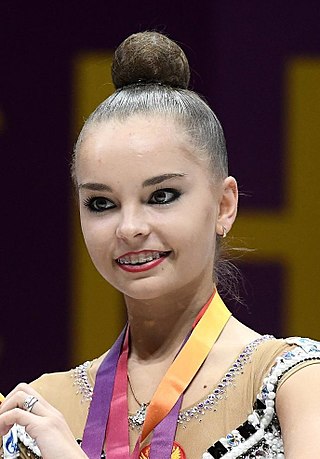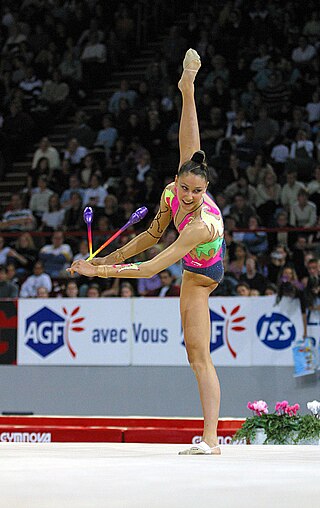This article needs additional citations for verification .(April 2015) |

In rhythmic gymnastics, a gymnastics ribbon is an apparatus composed of a handle (called "stick"), a ribbon, and attachment, that is used during a floor performance.
This article needs additional citations for verification .(April 2015) |

In rhythmic gymnastics, a gymnastics ribbon is an apparatus composed of a handle (called "stick"), a ribbon, and attachment, that is used during a floor performance.
The handle can be of any color and is usually made of wood, bamboo, or plastic. It has a maximum diameter of 1 cm (2/5") at its widest, a cylindrical or conical shape slip tape or may have a rubber handle for a maximum length of 10 cm (4") at the level of the grip. The top of
The ribbon is made of satin or another similar cloth, and can be of any color. It may be multicolored and have designs on it. The ribbon itself must be at least 35g (1 oz), 4–6 cm (1.6–2.4") in width and for senior category a minimum length of 6m (20') (5m (16.25') for juniors).
The ribbon must be in one piece. The end that is attached to the stick is doubled for a maximum length of 1m (3'). This is stitched down both sides. At the top, a very thin reinforcement or rows of machine stitching for a maximum length of 5 cm is authorized. This extremity may end in a strap, or have an eyelet (a small hole, edged with buttonhole stitch or a metal circle), to permit attaching the ribbon. [2]
The ribbon is fixed to the stick by means of a supple attachment such as thread, nylon cord, or a series of articulated rings. The attachment has a maximum length of 7 cm (2.8"), not counting the strap or metal ring at the end of the stick where it will be fastened. [3]
Rhythmic gymnastics routines require the ribbon to constantly be in motion. [4] Compulsory elements for the ribbon include flicks, circles, snakes and spirals, and throws. It requires a high degree of coordination to form the spirals and circles as any knots which may accidentally form in the ribbon are penalised. During a ribbon routine, large, smooth and flowing movements are looked for. [5]

Gymnastics is a type of sport that includes physical exercises requiring balance, strength, flexibility, agility, coordination, and endurance. The movements involved in gymnastics contribute to the development of the arms, legs, shoulders, back, chest, and abdominal muscle groups. Gymnastics evolved from exercises used by the ancient Greeks that included skills for mounting and dismounting a horse, and from circus performance skills.

In gymnastics, the floor is a specially prepared exercise surface, which is considered an apparatus. It is used by both male and female gymnasts. The gymnastics event performed on the floor is called floor exercise. The English abbreviation for the event in gymnastics scoring is FX.

Rhythmic gymnastics is a sport in which gymnasts perform on a floor with an apparatus: hoop, ball, clubs, ribbon and rope. The sport combines elements of gymnastics, dance and calisthenics; gymnasts must be strong, flexible, agile, dexterous and coordinated. Rhythmic gymnastics is governed by the International Gymnastics Federation (FIG), which first recognized it as a sport in 1963. It became an Olympic sport in 1984, with an individual all-around event. The group all-around competition was added to the Olympics in 1996. At the international level, rhythmic gymnastics is a women-only sport. The most prestigious competitions, besides the Olympic Games, are the World Championships, World Games, European Championships, European Games, the World Cup Series and the Grand Prix Series. Gymnasts are judged on their artistry, execution of skills, and difficulty of skills, for which they gain points. They perform leaps, balances, and rotations along with handling the apparatus.

The pommel horse is an artistic gymnastics apparatus. Traditionally, it is used by only male gymnasts. Originally made of a metal frame with a wooden body and a leather cover, the modern pommel horse has a metal body covered with foam rubber and leather, with plastic handles.

The rings, also known as still rings, is an artistic gymnastics apparatus and the event that uses it. It is traditionally used only by male gymnasts, due to its extreme upper body strength requirements. Gymnasts often wear ring grips while performing.

A lanyard is a length of cord, webbing, or strap that may serve any of various functions, which include a means of attachment, restraint, retrieval, activation, and deactivation. A lanyard is also a piece of rigging used to secure or lower objects aboard a ship.

The kong vong toch is a number of gongs that are attached to a circle-shaped rack, closely resembling its larger relative, the kong thom. Both instruments belong to the percussion family of traditional Khmer instruments, along with the roneat ek, roneat dek, and roneat thung. These instruments are all performed in the pinpeat and mahaori orchestras. The kong toch is made of three parts; the frame of the gong circle, the gongs themselves, and the gong mallets.

Rope(rhythmic gymnastics) may be made of hemp or a synthetic material which retains the qualities of lightness and suppleness. Its length is in proportion to the size of the gymnast. The rope should, when held down by the feet, reach both of the gymnasts' armpits. One or two knots at each end are for keeping hold of the rope while doing the routine. At the ends an anti-slip material, either coloured or neutral may cover a maximum of 10 cm (3.94 in). The rope must be coloured, either all or partially. It may be either of a uniform diameter or be progressively thicker in the center provided that this thickening is of the same material as the rope.

Twirling is a form of object manipulation where an object is twirled by one or two hands, the fingers or by other parts of the body. Twirling practice manipulates the object in circular or near circular patterns. It can also be done indirectly by the use of another object or objects as in the case of devil stick manipulation where handsticks are used. Twirling is performed as a hobby, sport, exercise or performance.
This is a general glossary of the terms used in the sport of gymnastics.

Evgeniya Olegovna Kanaeva OMF is a Russian individual rhythmic gymnast. She is the only individual rhythmic gymnast in history to win two Olympic all-around gold medals, winning at the 2008 Summer Olympics, where she finished with 3.75 points ahead of silver medalist Inna Zhukova, and at the 2012 Summer Olympics, where she also became the oldest gymnast to win the Olympic gold. On 4 July 2013, Kanaeva received the International Fair Play Award for "Sport and Life".

A hose strap is a piece of firefighting equipment. It can be "a short length of rope with an eye loop at one end and a metal hook at the other" or a piece of "flat nylon webbing sewn into a four-foot loop". Such a tool is routinely carried by firefighters in their structural turnout gear as a standard piece of personal equipment. While the variety with a metal hook may be more versatile, the nylon loop weighs less, is less expensive, and can be safely carried in a pocket. The hose strap has been a firefighting tool in common use since at least 1918, and appears as early as 1898 in an inventory list of Seattle, Washington municipal firefighting equipment.

Straps, also known as aerial straps, are a type of aerial apparatus on which various feats of strength and flexibility may be performed, often in the context of a circus performance. It is a cotton or nylon web apparatus that looks like two suspended ribbons. Wrapping the strap ends around hands and wrists, the performer performs holds, twists, rolls and manoeuvres, requiring extreme strength and precision similar to men’s rings in gymnastics. Straps are available in various configurations, including those with various types of loops at the ends and those without loops. A straps act usually includes held poses and postures done on the straps, dance moves performed on the floor away from the straps, partner acrobatics done on and off the straps, as well as having the straps pulled up and let down during the act.
The 1972 Pattern Webbing was intended to replace the 58 pattern webbing, but never got beyond user trials. It was made from PU-coated nylon to counter the Soviet NBC capability with a general look closer to a load-bearing vest. It was designed to be used in wide variety of environments such as jungles, deserts and was configurable for use, ranging from short-duration jungle patrols to general infantry use.

Yana Alexeyevna Kudryavtseva is a retired Russian individual rhythmic gymnast. She is the 2016 Olympic All-around silver medalist, three-time World Champion in the All-around (2013–2015), the 2015 European Games All-around champion, two-time European Championships All-around champion, the 2012 European Junior ball champion. In national level, she is a two-time Russian National All-around champion and three time Russian Junior National all-around champion.

Arina Alekseyevna Averina is a Russian individual rhythmic gymnast. She is a 2020 Summer Olympics finalist, a two-time world all-around silver medalist, a two-time European all-around champion and the 2016 Grand Prix Final all-around bronze medalist. She is a three-time (2019-2021) Russian national all-around champion and a three-time Russian national all-around medalist. Her identical twin sister Dina Averina is also a competitive rhythmic gymnast.

A watch strap, watch band,watch bracelet or watch belt is a bracelet that straps a wrist watch onto the wrist. Watch straps may be made of leather, plastic, rubber, cloth, or metal, sometimes in combination. It can be regarded as a fashion item, serving both a utilitarian and decorative function. Some metal watch straps may be plated with, or even in rare cases made of, precious metals.
Ekaterina Olegovna Vedeneeva is a Slovenian individual rhythmic gymnast.

Aurélie Lacour is a former French rhythmic gymnast. She represented her country in international competitions.